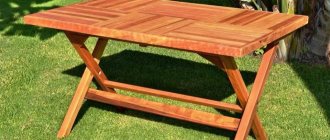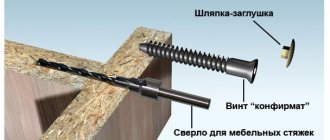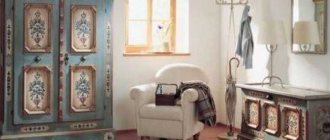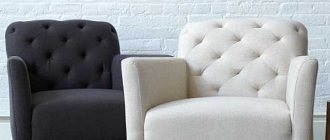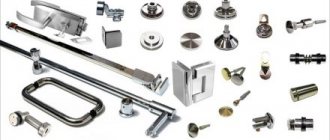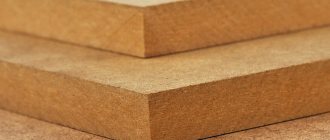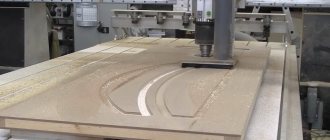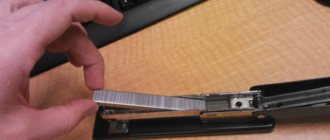An eccentric fastener (rastexes, minifixes, eccentric clamp - whoever calls it that) is one of the most common types of furniture fasteners.
Minifixes are good because parts fastened with their help can be disassembled and reassembled many times, without loss of rigidity, which would not happen when using confirmats, where with each assembly/disassembly the fastening will lose rigidity.
There is only one drawback to minifix furniture - it is painstaking work to install it. If you do not have expensive filler equipment, to install it yourself, you need to very carefully mark and accurately drill three different holes in three different planes, which usually takes a lot of effort and time.
This work does not tolerate mistakes in marking. After all, you won’t be able to adjust the connection in the end.
Also, its cost cannot be called completely cheap. The price of a minifix is usually 3-4 times more expensive than a confirmation.
Therefore, it should be used in the most necessary cases.
Where is it used?
An eccentric clamp is used in places where parts are fastened (T- or L-shaped), the connection of which must be hidden from prying eyes. For example, they fasten:
- Table tops for computer and other tables made of chipboard
- Dresser tops
- The bottom and roofs of sliding wardrobes and other parts where it is not possible to drill holes on the front part of the part.
The installed minifix rod of the eccentric clamp is completely hidden in the body of the chipboard, and only the eccentric remains visible, which is installed on the inside of the product.
How to choose the right screed
Choosing a suitable furniture tie is of great importance when assembling furniture. The final result in the form of a finished product depends on it. There are quite a few types of screeds, so each case requires an appropriate approach to assembly. The selected type of fastener should not interfere with the operation of the furniture or spoil its appearance. To ensure these conditions, it is necessary to choose the right furniture screed and not violate the assembly technology.
Cabinet furniture pieces are mainly designed to store various things. Therefore, when assembling them, it is necessary to ensure the strength of the connections. Confirmat screed is best suited for this. This fastener allows you to connect parts at the desired angle. And thanks to the holes for Euroscrews, drilled using a special drill for furniture screed, Confirmat ensures high-quality assembly of cabinet furniture. The main disadvantage of confirmations is the unaesthetic appearance of the hats, which, although they remain flush, are still very noticeable.
An eccentric tie is another type of fastener used in assembling cabinet furniture. It is used where it is necessary to hide fasteners, for example, on the facade of furniture. The main advantage of eccentric fasteners is hidden installation.
Its high load-bearing capacity is due to its design. Cabinet furniture is a prefabricated structure consisting of several pieces of furniture connected to each other. This necessitates the use of an intersectional tie, which is designed to tighten adjacent pieces of furniture.
The main purpose of upholstered furniture is comfortable rest. Therefore, it should be comfortable, practical and last long enough. Fastening of upholstered furniture with a carriage screed must be reliable and have an aesthetic appearance. Ideally it should be invisible. All these requirements are met by a furniture bolt with an eternal companion, a nut. With such metal fasteners, the furniture will withstand the mechanical loads exerted on it during operation. In addition, the semicircular head of the bolt, which protrudes slightly above the surface of the parts, will be completely invisible under the upholstery, especially if there is a carriage tie on it.
Built-in furniture is designed to store things and objects for various purposes. Very often, such structures consist of only shelves installed in niches or along the walls. Therefore, the best fasteners for them can be confirmations and furniture corners. If the design of built-in furniture does not provide for the installation of facades, it is advisable to use eccentrics and minifixes as fasteners. These fasteners are installed without through drilling, which allows you to maintain the aesthetic appearance of the structure.
Today, furniture in which individual parts are made of glass sheets is especially popular. They are quite fragile, so glass furniture fasteners must have a large margin of strength and are naturally made from other materials. For this reason, to tie it down, it is better to use special types of metal fasteners (clamps, holders) complete with rubber gaskets. To install them, not only drilling is used, but also fastening with glue.
Types of eccentric couplers
Depending on the manufacturer, there are several modifications of the minifix, which includes:
- Rod (rastex)
- Eccentric (minifix)
- Plastic or metal bushing (depending on manufacturer)
- Minifix stub (optional)
There are also corner (hinged) and double-sided couplers. But to use them you need to be a complete pervert, and also think carefully about where they can be used. Nowadays, they have practically ceased to be used due to their uselessness.
Today, the eccentric clamp remains popular, the rod of which comes with a thread for chipboard, without a plastic sleeve. That is, it consists of only two parts: the rod and the eccentric.
But, just in case, in this article we will analyze the installation of two types of this fastener - both with and without a bushing.
Manufacturing materials
Eccentric couplers are made of both metal and plastic. Plastic split-spacer ones are better suited for small horizontal objects like shelves and for lightweight products. It is much easier to install them; just insert the rod into the continuous end and hit it with a hammer several times. However, if a lot of weight presses on them, such footers can spread out excessively and damage the chipboard: sooner or later a crack will appear, which will then spread further. To secure the plastic, it is sometimes recommended to use glue: it is poured into the hole where the coupling is inserted.
Scope of application of furniture hinges with a closer, installation features
It is more difficult to screw in a metal minifix, but it will withstand, for example, a heavy kitchen set without damaging the furniture itself. Glue is definitely not required here, but countersinking is required - additional alignment of the holes. Unlike plastic, steel is not as malleable and will not conform to the shape of a recess under pressure.
When installing ties and then transporting the finished product, you need to remember that plastic will not scratch adjacent parts, but metal can. If stainless steel bushings have been selected, it would be a good idea to take additional safety precautions.
Metal
Plastic
Installation instructions for eccentric coupler (without bushing)
Required tool:
- Screwdriver
- Forstner cutter 15 mm
- Drill 7 mm (for rod body)
- Drill 5 mm or confirmat (for screwing in the rod)
- Ruler, awl, pencil
The standard thickness of the tie rod body is 6 mm, and the length is 44 mm. The eccentric diameter is 15 mm and its depth is 12.5 mm. Photo of eccentric and rod:
As mentioned above, to install a minifix, three holes of different diameters need to be made in the parts to be joined.
So let's start assembling.
For high-quality assembly, so that the eccentric grips the rod head, it should protrude 6 mm:
To screw the rod into the chipboard, a hole is made with a 5 mm drill (or a confirmed one); if it is a sidewall, its center should be located at a distance of 8 mm from the edge, 10-11 mm deep (the rod should be screwed in tightly and to the very end, this can be seen from the mark on the picture).
In another part, markings are made for two holes.
The first is at a center distance of 34 mm from the edge, under the hole with a Forstner cutter with a diameter of 15 mm. Its depth must be equal to the thickness of the eccentric (about 12 mm) so that the eccentric fits flush into the part.
The second hole is made at the end of the part, strictly in the center, with a 7 mm drill (1 mm larger than the rod body).
Next, the eccentric rod is screwed into the 5 mm hole, the second part is mounted on it, and the structure is clamped with a minifix.
Rules for working with furniture fittings
Having understood the main types and purposes of furniture fasteners, you should also study general recommendations for working with them:
- Tools for assembling furniture are selected taking into account the type of material. For soft (chipboard) rocks you need a wrench and a hex wrench. In hard (solid wood) fasteners can be screwed in with a screwdriver without fear of damaging the furniture panel.
- If the furniture is made independently, before installing the connecting fittings it is necessary to carry out drilling: you cannot immediately screw in a Euroscrew or other fasteners, the chipboard may delaminate and warp. Furniture that is manufactured at the factory already has drilling; it is performed by the manufacturer.
- To install the main types of fastening hardware, you will need special bits for a screwdriver. In addition, you may need wood glue, wood drills of different diameters, a jigsaw and pliers.
A variety of fastening fittings allows you to securely and discreetly fasten furniture parts at any angle. The main thing is to choose the right connecting elements and install them.
LiveInternetLiveInternet
Minifix
or as it is also called - an eccentric tie, a fairly common type of fastener for assembling furniture from laminated chipboard.
I most often use minifix for the manufacture of furniture, which is often subjected to a “disassembly-assembly” cycle. For example, for furniture that is often transported from one place to another. Or for temporary furniture, for example tables, which after short-term use can be easily disassembled and stored until subsequent assembly, when they are needed again. Minifix is also used in cases where, according to the design project, there should be no visible fasteners on the furniture or part of it on the front side. Those. In fact, minifix is a semi-hidden furniture fastener. In the installed minifix, only the eccentric is visible, which is usually located on the inside of the mount.
Advantages of minifix:
- Minifix is a furniture fastener for quick installation. Those. Assembling furniture from parts with already installed minifixes does not take much time. And to do this, a simple flat-head screwdriver is enough.
- Minifix is a reliable fitting; it can withstand many assembly-disassembly cycles without losing the quality and strength of the connection.
- There is no visibility of the fastening from the front side. The minifix eccentric can be installed in an inconspicuous part of the fastening unit.
Disadvantages of minifix:
- Greater cost than the classic confirmat. And in furniture where there are many areas for fastening parts, a large number of minifixes can affect the final cost of the entire product.
- A more complex technology for installing this type of fastener. If when installing a confirmat it is necessary to make two mounting holes, when installing a minifix, you will need three such holes. Confirmat is a fastener consisting of one element. Minifix consists of three parts.
How to install minifix.
Minifix coupler is a three-element type, consisting of a metal eccentric, a plastic coupling and a rod (eccentric rod).
To install the minifix you will need: a milling cutter with a diameter of 15-16 mm, drills 7 and 10 mm.
In its cutting part, a minifix cutter exactly resembles a hinge cutter.
The procedure for installing minifix.
These are the details, using an example of which I will show the process of installing minifix.
1.
Minifix installation diagram.
| In this example, we will consider the installation of a classic minifix 42 mm long, designed for installation in a 16 mm thick slab. Almost all the different types of minifixes are described below. |
2.
We start by using a 10 mm drill in the plane of the part that is being attached. Drill a blind hole for the plastic coupling.
We make markings as usual. 8 mm is the middle thickness of the laminated chipboard.
Hole for minifix coupling.
A drop of glue (PVA or B3) so that the coupling is installed more firmly. Although this operation is not necessary. The diameter of the coupling itself is approximately 10.5 - 10.6 mm. Those. It is installed in the part so firmly enough.
The coupling is driven into the hole flush with the surface of the part. The minifix rod will be screwed into it.
3.
We drill a blind hole for the eccentric.
For this type of minifix, the size for the eccentric from the end of the abutment to its center is 34 mm.
For accuracy of subsequent assembly, the remaining dimensions at the end and the abutment plane must match according to the preliminary design.
It should be noted that the distance is 34 mm. is not universal for all minifixes. There are minifixes in which this distance is 28 or 30 mm. Finding out the installation size of the eccentric is not at all difficult; you can look at the diagram or simply measure the rod itself with a ruler (more on this in this article, see below).
Depth of hole for eccentric = 14 mm. The thickness of the eccentric itself (for a 16 mm minifix) = 13.5 mm. Those. the eccentric should fit flush into the hole (slightly below the plane by 0.5 mm)
4.
Hole for minifix rod.
The last thing to do is to drill a hole at the end of the mating part for the minifix rod so that it goes into the eccentric hole.
The hole is drilled with a drill with a diameter of 7 mm. It is 0.5 mm wider than the diameter of the rod.
Minifix installed.
A decorative plastic plug is installed on the eccentric. There are also thin self-adhesive plugs, like those that are hung on confirmat hats, only with a slightly larger diameter.
Assembly and disassembly of the connection unit on the minifix occurs using a regular flat-head screwdriver.
Types of minifixes.
Simple minifixes. I managed to put together several types of simple minifixes. see photo.
Minifixes on the left, 2 pcs. — under the slab 18 mm. (this can be seen by the size of the eccentric). Also, the minifixes on the left are installed without a coupling; they are directly screwed into the part. To do this, drill a hole, like for a shelf holder.
Minifixes on the right, 3 pcs. — under the slab 16 mm. All three are installed via a coupling. Although the two middle ones can also be installed directly. One of the minifixes is shortened by the size up to the eccentric 25 mm. (used mainly for table tops in office furniture).
With simple minifixes, you often come across ones whose size to the eccentric is 30 mm. In general, this size does not depend on the standard, but on the “invention” of the minifix manufacturer.
There are also mini-fixes, corner (hinged) and tie-down (double-sided).
Corner minifix and its installation diagram. Here, the “X” dimension is the size along the surface of the part, and not along the axis of the rod. With different connection angles, this size will change, while the size of the rod does not change.
Minifix coupling, installation diagram. It is also called an eccentric coupler.
Various variations of minifixes.
How to find out the size for the minifix eccentric.
It's very easy to do. Minifix head = 3 mm. thick. And 3 mm. you need the rod neck so that the eccentric grabs the head. This means that 6 mm must be subtracted from the length of the rod. - this will be the size for the eccentric. Also with a corner minifix. You need to take the size of the rod from the center of the joint and minus 6 mm.
What is a furniture jig and how to use it
If you have a furniture jig, this will make it much easier for you to mark and drill holes for any type of fastener. A jig is essentially the same template, which is a special device or bar on which holes of different diameters and at different distances are applied. With their help, you can make perfectly accurate markings and drill passages of the size you need. Various materials are used to make this assistant:
- metal;
- plastic;
- tree;
- wood boards.
The product is a solid base with many holes at different distances required from each other. Additionally, it can be equipped with a mechanism for fixing and adjusting the distance between the holes.
Use a special drilling jig to help you hold the drill at the right angle.
Thanks to the device, you will install the drill exactly at a right angle to the blade, without deviations. This is a great help when working on narrow surfaces, such as the ends of chipboards. After all, if the groove is not located at an angle of 90 degrees, assembling the body elements into a single whole may become impossible.
Types of conductors
Depending on the functions performed and design features, templates can be of several types:
- Invoices. This type of device serves as an assistant for drilling holes on flat elements by placing it on the workpiece. The device is not attached, but only held by hand. Suitable for use on chipboard or fibreboard surfaces.
- Rotary. The rotating device allows you to move it vertically or horizontally and rotate it at different angles. This device is convenient to use provided that the part that needs to be drilled has a complex shape.
- Tiltable. Tiltable assistants are convenient for working with elements that are located in planes that are different from each other.
- Universal. The devices are convenient because they can be customized for the production of furniture of various configurations.
All types of templates can have a sliding or fixed type of fit to the surface. The sliding type allows you to move the product along the surface of the workpiece. Fixed option - firmly fixed in the desired position and does not move.
The conductor is the furniture maker’s best assistant, without him it would not have been possible to connect furniture so beautifully
Prices for drilling jigs
Drilling jig
What to look for when choosing a conductor
When choosing a furniture jig in a store, you should carefully examine the product and pay attention to the material from which it is made. For example, stainless steel products will be high-quality and reliable.
The manufacturer matters too. World-famous brands, as a rule, produce high-quality tools with a long service life and a warranty from the manufacturer.
The more famous the brand, the higher the quality - a rule that works flawlessly in the case of construction tools
When purchasing such an assistant, take an interest in the additional equipment that comes with the kit. The versatility of the device will make your work easier. The more tools included in the package, the more cases you will be able to use it. For example, a set may include
- various bushings;
- drills of various diameters with stops;
- Forstner cutter, for holes for minifixes;
- keys.
There are a significant number of advantages in using this device.
By using a template when manufacturing and assembling cases, you will save yourself from many inconveniences. For example, you don't need to mark places with a ruler and pencil. The jig allows you to fix the distance and drill several absolutely identical holes at the same distance from each other. There is no inaccuracy here.
But a factory-made conductor also has a drawback - its rather high price.
Therefore, craftsmen are quite capable of making such an assistant with their own hands. Our instructions will help you with this.
Instructions for making a furniture jig
Step No. 1 – prepare tools and materials:
- square metal block, section 1x1 cm;
- Bulgarian;
- file;
- calipers;
- awl or thick needle;
- drills with a diameter of 5 mm;
- metal plate for stop measuring 1x25 mm;
- a sheet of sandpaper.
First, let's collect all the tools and materials necessary for the work.
Step No. 2 – make the base and markings. Using a grinder, cut off a piece of the required length from the block. Sand any burrs with a file. Mark the locations for future holes. The generally accepted dimensions are the distance between the grooves is 32 mm, the distance from the centers of the slots to the side edge is 8 mm. To make the markings accurate, use a caliper. It is convenient if you mark the centers of future grooves using an awl or needle.
Make the markings, you can first do it on paper, then transfer it to the material itself that requires connection
Step No. 3 – install the tool. Next, we drill passages in the required quantity. Then we take a metal plate and grind it with sandpaper if necessary. Clamping it with a vice, we bend our plate at a right angle. Align the resulting parts and clamp them with a clamp. Fasten the parts with screws, having previously cut the thread to the desired size. Thus, you can create a very convenient tool for yourself.
Next we drill the holes
Advantages and disadvantages
Like any type of fastener, an eccentric connection has its positive and negative sides. Let's look at them using a table as an example.
Table 1. Advantages and disadvantages of an eccentric coupler
| Advantages | Flaws |
| 1. Furniture can be assembled and disassembled quickly and effortlessly. 2. Possibility of repeated assembly and disassembly of products. 3. The most reliable and durable mounting option. 4. Does not spoil the appearance of the product. 5. Possibility of fastening products at different angles. | 1. High price of fasteners. This increases the cost of the product as a whole. 2. The installation technology is quite complex. 3. The need for perfectly accurate calculations for marking locations for fastenings. |
What does an eccentric coupler look like when it's in place?
